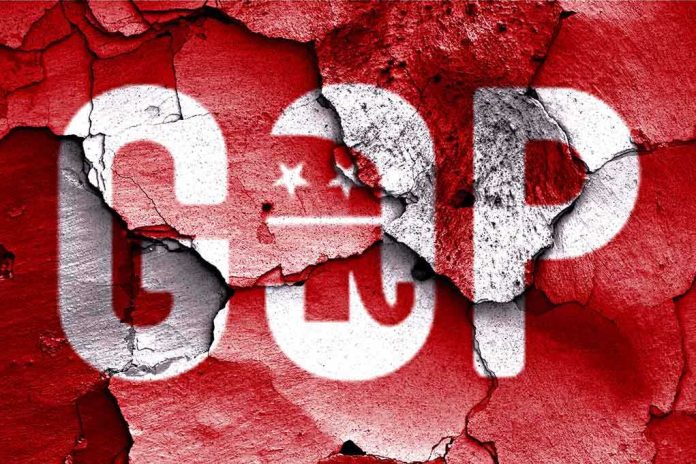
Trump’s threat to oust Indiana Republicans over redistricting reveals how far national party power brokers will go to redraw America’s political map and punish dissent—setting the stage for a high-stakes internal showdown that could upend the House after 2026.
Story Snapshot
- Trump publicly threatens Indiana GOP lawmakers with primary challenges for stalling redistricting.
- Indiana Senate President Pro Tem Bray and Governor Braun are directly targeted, exposing party fractures.
- Redistricting emerges as the latest battleground for control of the U.S. House in 2026.
- National party intervention in state affairs intensifies as both parties deploy aggressive map strategies.
Trump’s Redistricting Ultimatum Shakes Indiana GOP
President Donald Trump ignited a political firestorm by threatening Indiana Republican lawmakers who refuse to advance a new redistricting plan. His pointed message: any Republican failing to support the effort risks facing a primary challenger backed by Trump himself. The threats followed a Friday announcement from Indiana Senate President Pro Tem Rodric Bray, who declared there was insufficient support in the chamber to proceed. By Sunday, Trump had escalated his rhetoric on Truth Social, naming Bray and Governor Mike Braun as obstacles to Republican success and warning they were endangering the party’s prospects for House control after the 2026 midterms.
Trump’s tactics draw on his trademark approach—leveraging mass media and social platforms to rally his base and pressure lawmakers. His words carry weight among conservative voters, and the specter of a Trump-backed primary challenge looms large for any incumbent. This episode marks a direct presidential intervention into state legislative affairs, a rarity even in today’s hyper-partisan climate. The move mirrors national Republican strategies in states like Texas, Missouri, and North Carolina, where legislatures are pushing for favorable district maps, while Democrats execute countermeasures in California and beyond.
How Redistricting Became a National Power Play
Redistricting, the process of redrawing electoral districts, is historically fraught with partisan maneuvering. After each census, states redraw maps, often seeking to tilt the electoral field to their party’s advantage—a practice known as gerrymandering. In Indiana, the issue has simmered for years, but Trump’s intervention has turned a local legislative debate into a flashpoint of national consequence. Recent pressure from Trump led Governor Braun to call a special session, only for Bray to announce the plan lacked the necessary votes. The resulting stalemate exposes deep divisions within the Indiana GOP and underscores the risks of national figures imposing top-down discipline on state lawmakers.
Trump’s threats are not idle. He has a track record of using public statements and social media to enforce party loyalty, often by endorsing primary challengers to sitting Republicans seen as insufficiently supportive. The dynamic now unfolding in Indiana is a case study in how national leaders can override local interests, propelling state-level disputes onto the national stage. The stakes are high: the redrawing of district maps could determine the balance of power in the U.S. House for years to come, making every legislative decision a potential flashpoint.
Internal GOP Fractures and the Risk of Primary Challenges
Indiana Republicans find themselves caught between local priorities and Trump’s demand for party unity. Senate President Bray and Governor Braun are under public fire, and other lawmakers now face the threat of primary challenges if they oppose redistricting. Trump’s message is clear: “Any Republican that votes against this important redistricting, potentially having an impact on America itself, should be PRIMARIED.” Such direct intervention is nearly unprecedented, raising questions about legislative independence and the future of state-federal party relations.
The Indiana Democratic Party, meanwhile, opposes the GOP’s redistricting push and seeks to secure or expand its representation. National Democratic leaders are deploying their own aggressive map strategies in states like California, where they recently passed a ballot measure for a more favorable House map in 2026. As both parties escalate their tactics, voters are left watching a spectacle where local representation collides with national ambitions. The outcome in Indiana could set a precedent for further interventions and intensify the battle for control of Congress.
National Implications and the Battle for the House
The fallout from Trump’s threats will shape Indiana’s political landscape in the short term, heightening intra-party conflict and possibly delaying or derailing redistricting efforts. Lawmakers who defy Trump risk losing their seats, while those who comply may face backlash from constituents wary of outside interference. In the long run, renewed redistricting could shift the composition of Indiana’s congressional delegation, with ripple effects felt across the national landscape.
This episode also exemplifies broader trends in American politics: the increasing willingness of national leaders to intervene in state affairs, the use of primary challenges as a tool for party discipline, and the centrality of redistricting to partisan strategy. As the 2026 midterms approach, both parties will continue to battle for favorable maps, legal challenges will proliferate, and campaign spending will surge. The drama in Indiana may be the opening act in a nationwide contest for control of the U.S. House, with the rules of engagement rewritten for a new era of political hardball.
Sources:
KSBY – Trump Slams Indiana Republicans for Not Moving Forward With Redistricting Effort









